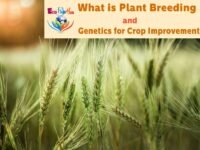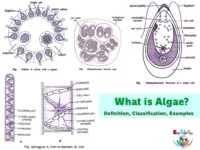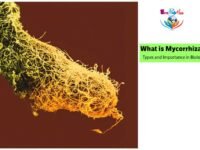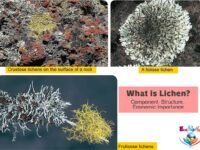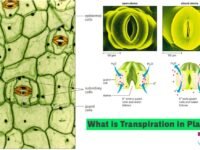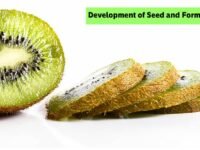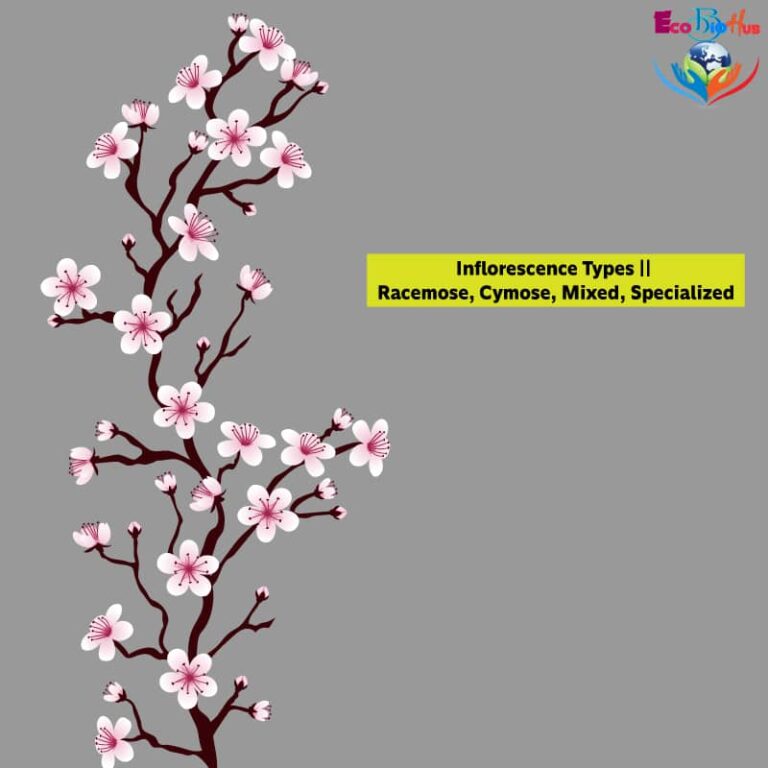TABLE OF CONTENTS
Inflorescence Definition
– The arrangement and distribution of more than one flowers on a floral axis is called inflorescence. In other words, inflorescence is the name of a modified shoot that is specialized to bear flowers. Flowers are borne singly or in clusters.
– The main axis of the inflorescence together with the lateral axes, if present, is known as peduncle. A flattened peduncle is known as receptacle.
– Stalk of the individual flower is called pedicel. The individual flowers arise in the axil of special leaves, called bracts.
– The floral axis may be simple (i.e., unbranched) or compound (i.e., branched).
– In unbranched condition, the flowers are borne on the simple axis called rachis. In branched axis, the flowers are borne only on the branches which are called rachises. The production of flowers on the old stem is called cauliflory.
– The aggregation of flowers in an inflorescence has the following advantages:
1. It makes the flowers of inflorescence more prominent to attract insects for pollination.
2. Many flowers get pollinated by a single insect.
3. Inflorescence provides greater chances of seed production.
Table: Differences between Pedicel and Peduncle inflorescence
| Sl. No | Pedicel | Peduncle |
| 01. | It is stalk of the flower. | It is flower bearing axis of the inflorescence. |
| 02. | A pedicel bears a single flower. | A peduncle generally bears several flowers. |
Inflorescence Types
– Inflorescence is of five main types: Solitary, Racemose, Cymose, Mixed, and Specialized.
I. Solitary Inflorescence
– The flowers that arise singly at the axil of vegetative leaf are solitary flower, e.g., china rose, Datura.
Solitary flowers are formed by direct transformation of shoot tips into flowers. They are of two types:
– Solitary terminal: Single flower occurs at the tips of the main stem and its branches, e.g., poppy (Papaver).
– Solitary axillary: Single flower occurs in the axils of ordinary green or foliage leaves, e.g., Hibiscus, Petunia, garden nasturtium, shoe flower, guava.
II. Racemose Inflorescence
Racemose inflorescence is an indeterminate inflorescence which shows indefinite growth and bears a number of flowers due to the presence of active growing points.
This inflorescence is also called indefinite and indeterminate type. The growth of the peduncle is indefinite. Here the terminal bud will not modify into a flower.
The arrangement of flowers is either acropetal (i.e., older towards the base and younger towards the apex) or centripetal (i.e., older towards the periphery and younger towards the centre).
Racemose inflorescence is of two types, simple racemose and compound racemose.
A. Simple Racemose Inflorescence
Simple racemose inflorescence is that indefinite inflorescence in which the peduncle is unbranched.
Simple racemose inflorescence is of the following types:
01. Typical Raceme
The main axis is elongated and unbranched. Flowers are stalked (pedicellate) and arranged in an acropetal fashion, i.e., older flowers are borne at the base and younger flowers towards the apex.
Examples: Mustard (Brassica), Larkspur (Delphinium), Cassia, Radish (Raphanus), Lupin (Lupinus) etc.
02. Spike
The main axis is elongated. The flowers are sessile and arise in an acropetal fashion.
Examples: chaff flower (Achyranthes), bottle brush (Callistemon), vasaka (Adhatoda vasica), Amaranth.
03. Spikelet
Spikelets arise in a raceme manner on the main axis. The axis is reduced bearing one or a few flowers. Each spikelet bears at its base two minute bracts called empty glumes. Slightly higher up, it bears a third bract called glume or lemma or lower palea. Opposite to the lemma, it bears a small glume called upper palea. Each spikelet remains enclosed by a lemma and palea.
Examples: They occur in family Gramineae ( (= Poaceae) i.e., Wheat, Rice, oat, grass, etc.
04. Catkin or Amentum
Its main axis is long and pendulous. Flowers are unisexual deciduous and sessile arising in an acropetal manner, often hanging, spike which matures and falls down as a single unit.
Examples: Mulberry (Morus), Poplar (Populus), willow (Salix), red hot cattail (Acalypha hispida), Betula, Quercus.
05. Spadix
It is an elongated spike with fleshy axis (peduncle
Examples: maize, banana, Colocasia, Arum.
In a spadix, the appendix of the peduncle and the spathe are coloured to attract insects for pollination. The spathe is tubular in the basal region to protect the flowers.
Table: Differences between Catkin and Spadix inflorescence
Sl. No
Catkin
Spadix
01.
A spathe is absent.
Spadix has a large bract called spathe.
02.
Flowers are not protected.
Flowers are protected by the basal tubular part of the spathe.
03.
Male and female flowers develop on separate catkins.
Male and female flowers may develop on the same or different spadices.
04.
No part of the peduncle is sterile.
Upper part of the peduncle is sterile and is called appendix.
05.
Pollination agencies are not attracted by spathe and appendix.
Pollinating agents are attracted by spathe and appendix.
06.
Catkins usually occur in a hanging position.
Spadices are usually upright.
Table: Differences between Spike and Spadix inflorescence
| Sl. No | Spike | Spadix |
| 01. | A spathe-like covering is absent. | The inflorescence is covered by a large bract called spathe. |
| 02. | The peduncle is nonfleshy. | The peduncle is fleshy. |
| 03. | The whole peduncle is covered by flowers. | The apical part of peduncle, called the appendix, is naked, i.e., without flowers. |
06. Corymb
Corymb is similar to raceme but the main axis is short and flowers are pedicellate. Lower flowers have longer pedicels so that all the flowers lie more or less at the same level.
Examples: Candytuft (Iberis amara), Cherry, etc.
07. Corymbose Raceme
In corymbose raceme, the young flowers appear to be arranged like a corymb but in mature state, the longer pedicels of the lower flowers do not bring them to the level of upper ones.
Examples: Mustard.
08. Umbel
In umbel inflorescence, due to condensation of the axis, the flowers appear to be arising from one point in a centripetal manner (outer flowers are more mature).
An involucre or whorl of bracts is often present at the base of flowers, e.g., family Umbelliferae (=Apiaceae). The flowers in an umbel type of inflorescence usually have stalks of equal length.
Examples: Hydrocotyl, Centella asiatica (Brahmi), Androsace.
Table: Differences between Corymb and Umbel inflorescence
Sl. No
Corymb
Umbel
01.
Peduncle is well-developed.
Peduncle is reduced to a point.
02.
The flowers arise at different levels from peduncle.
All the flowers radiate out from a common point.
03.
The pedicels of the older flowers are much more elongated as compared to those of younger flowers.
There is a little difference in the pedicel length of different flowers.
04.
The arrangement of flowers is acropetal though from above it appears to be centripetal.
The arrangement of flowers is centripetal.
05.
An involucre is always absent. Bracts, if present, occur at various levels depending upon the origin of flowers.
An involucre is often present at the place of origin of flowers.
09. Capitulum or Racemose Head
It is considered the most perfect and advanced type of inflorescence. It is the characteristic type of inflorescence of the family Compositae (= Asteraceae). Here the peduncle is highly condensed and flattened disc-like called as receptacle and bears numerous small sessile flowers, called florets. The florets are arranged in a centripetal fashion i.e., younger ones towards the centre and older ones towards the periphery. The florets are surrounded and protected by an involucre of bracts. The florets are of two types namely, ray florets and disc florets. Ray florets are usually female and zygomorphic and disc florets are bisexual and actinomorphic.
– Ray florets are situated at the periphery. They are zygomorphic females or sterile.
– Disc florets, present in the centre of the receptacle, are tubular, bisexual and actinomorphic.
The head inflorescence is characteristic of family Compositae.
Heads are of two types viz., homogamous head and heterogamous head. • Homogamous head – • Heterogamous head – The head/capitulum consists of different types of florets, it is described as heterogamous head, e.g., Tridax, Helianthus, Cosmos. In the heterogamous heads, the ray florets are towards the periphery and disc florets are at the centre of the inflorescence. The inflorescence becomes conspicuous and attractive due to the brightly coloured ray florets. Head inflorescence is considered to be a highly evolved type among the inflorescence because: – There is an economy of biological materials. – Enhancement of attraction due to aggregation of florets. – Maximum protection of flowers is ensured. – A single visit of the insect can pollinate many flowers.
Table: Differences between Umbel and Capitulum inflorescence
Sl. No
Umbel
Capitulum
01.
The peduncle or axis is reduced to a point.
The peduncle or axis is reduced but flattened to form a receptacle.
02.
The flowers are pedicellate.
The flowers are sessile.
03.
The flowers are of one type.
A capitulum can bear one or two types of flowers (tubular and ligulate).
04.
The individual flowers are well spaced out from above, though they develop from the same point.
Capitulum is a compact inflorescence where individual flowers are not spaced out.
05.
Umbel is a modification of raceme.
Capitulum is a modification of spike.
06.
Bracts other than those of involucre are absent.
Bracts other than those of involucre may be present.
07.
A single whorl of involucre lies at the base.
The involucre is generally made of more than one whorl.
B. Compound Racemose Inflorescence
It is an indefinite or indeterminate inflorescence in which the peduncle is branched in a racemose fashion with each branch bearing flowers in an acropetal or centripetal fashion.
01. Panicle / Compound Raceme (raceme of racemes)
When the raceme is branched, it is called compound raceme or panicle e.g., Neem (Azadirachta indica), Cassia fistula, Yucca, Gold Mohur (Delonix), Litchi, Mango etc.
02. Compound Corymb (corymb of corymbs)
E.g., Pyrus, Cauliflower (Brassica oleracea), Candytuft. In Cauliflower, the flowers remain undeveloped.
03. Compound Umbel (umbel of umbels)
In compound umbel, the peduncle is branched. All the branches develop in an umbellate manner. Each branch bears flowers as in a simple umbel. A whorl of bracts present at the base of the branches is called involucre and those that surround the flowers are called involucel.
Compound umbel is a characteristic type of inflorescence in Umbelliferae, e.g., Coriander (Coriandrum sativum), Fennel (Foeniculum vulgare), Cumin (Carum), golden alexanders (Zizia aurea), Carrot (Daucos carota).
04. Compound Spike (spike of spikes)
In a compound spike, the inflorescence axis of a spike is branched and the branches bear sessile flowers (flowers are arranged like that in spike), e.g., Amaranthus spinosus.
05. Compound Spadix (spadix of spadices)
E.g., Date, Coconut.
06. Compound Capitulum (capitulum of capitulum)
A compound capitulum is formed when the main inflorescence axis is branched and several capitula are included within a common involucre. In compound capitulum each head has a single floret subtended by its own involucre, e.g., Echinops echinatus.
III. Cymose Inflorescence
Cymose inflorescence is the name of determinate or definite inflorescence in which the tip of the main axis terminates in a flower and further growth continues by one or more lateral branches which also behave like the main axis. The arrangement of flowers is either basipetal (i.e., younger towards the base and older towards the apex) or centrifugal (i.e., younger towards the periphery and older towards the centre)
On the basis of the arrangement of flowers, cymose inflorescence is of three types: uniparous (or monochasial cyme), biparous (or dichasial cyme), multiparous (or polychasial cyme).
01. Uniparous or Monochasial Cyme
The peduncle (or main axis) ends in a flower. Below this flower, only one lateral branch develops from the axil of a bract. This branch also ends with a flower. The same process is continued. Since only one branch develops from below each flower, it is called monochasial cyme
Uniparous cyme inflorescence is of two types:
(i) Helicoid Uniparous Cyme: All the flowers are borne on the same side (either on the left or right) of the main axis forming a sort of helix, e.g., Drosera, Begonia, Heliotropium, Solanum.
Helicoid uniparous cymes are of two types:
(a) Drepanium – when the lateral branches are in the same plane.
(b) Bostryx – when the lateral branches are in a different plane.
(ii) Scorpioid Uniparous Cyme: Flowers are alternately borne on both sides (to the right or left) of the main axis, forming a zigzag, e.g., Freesia, Tecoma, Ranunculus bulbosus.
Scorpioid uniparous cymes are of two types:
(a) Rhipidium – when the lateral branches are in the same plane, e.g., Solanum nigrum.
(b) Cincinnus – when the lateral branches are in a different plane.
02. Biparous (or Dichasial) Cyme
In biparous cyme, the main axis terminates into a flower. Two lateral branches develop on either side of the main axis. Lateral branches also end into a flower and may again branch similarly.
Examples: Pink (Dianthus), Ixora, Nyctanthes ( vern, Har Singar ), Spergula, Silene, jasmine (Jasminum), clerodendron ( Clerodendrum ), Bougainvillea, teak, etc.
03. Multiparous (or Polychasial) Cyme
In this case, the main axis terminates into a flower and then it produces a whorl of more than two lateral branches, and each lateral branch terminates into a flower. The process is repeated.
Examples: Calotropis, Hamelia patens, Asclepias.
04. Cymose Head (Glomerule)
Sessile or subsessile flowers are borne centrifugally around a receptacle.
Examples: Anthocephalus cadamba ( vern . Kadam), Acacia, Albizia.
Table: Differences between Racemose and Cymose inflorescence
Sl. No
Racemose
Cymose
01.
The growing point seldom ends in a flower.
The growing point always forms a flower.
02.
The floral axis or peduncle is monopodial.
The floral axis or peduncle is sympodial or multipodial.
03.
The formation of flowers is indefinite or unrestricted.
The formation of flowers is definite or restricted.
04.
The arrangement of flowers is acropetal.
The actual arrangement of flowers is basipetal which is clearly visible in biparous and multiparous cymes.
05.
The arrangement of flowers in a group is centripetal, that is, the younger flowers are towards the centre and the older towards the outside.
The arrangement of flowers in a cymose head and other types of groupings is centrifugal, that is, the older flowers are towards the centre and the younger towards the periphery.
IV. Special Types of Inflorescence
Special types of inflorescence are basically cymose but ultimately it is modified to form a special appearance.
Different types of special inflorescence are – cyathium, coenanthium, hypanthodium and verticillaster.
01. Hypanthodium
Hypanthodium is a specialised form of racemose inflorescence. The main axis forms a hollow cup-shaped receptacle with a small opening at the top, is called ostiole. The ostiole of hypanthodium is guarded by scales and flowers are borne on the inner side of the cavity. It facilitates the entry of insects for pollination.
Male flowers are borne at the upper side and female flowers are at the basal side. In between the male and female flowers, sterile female powers (gall flowers) are present.
Examples: Hypanthodium is found in the genus Ficus of family Moraceae, e.g., Ficus religiosa (Peepal), Ficus benghalensis (Banyan), Ficus carica (Fig).
Table: Differences between Capitulum (Racemose head) and Hypanthodium inflorescence
| Sl. No | Capitulum (Racemose head) | Hypanthodium |
| 01. | Receptacle consists of a flattened disc or upright column. | Receptacle is flask-shaped. |
| 02. | Receptacle is open from above. | Receptacle is closed except for a pore lined by scales. |
| 03. | Receptacle does not become fleshy. | Receptacle becomes fleshy. |
| 04. | The flowers are well exposed. | The flowers are not exposed. |
| 05. | An involucre occurs at the base. | An involucre is absent. |
| 06. | Capitulum may be homogamous or heterogamous. | Hypanthodium is always heterogamous. |
| 07. | It is racemose in nature. | It has three condensed cymes. |
| 08. | The flowers are generally bisexual. | The flowers are unisexual and show a distinct distribution. |
02. Cyathium
Cyathium is a modified cymose inflorescence which looks like a single flower. It consists of a single median female flower surrounded by numerous male flowers. Female flower is pedicellate and consists of pistil only borne on a long stalk, the gynophore
Examples: It is characteristic of the family Euphorbiaceae (of genus Euphorbia).
Table: Differences between Capitulum (Racemose head) and Cyathium inflorescence
| Sl. No | Capitulum (Racemose head) | Cyathium |
| 01. | This is a racemose type of inflorescence. | This is a special type of cymose inflorescence. |
| 02. | Bracts of the involucre are free. | Bracts of the involucre are fused. |
| 03. | Nectaries do not occur over the involucre. | Nectaries usually occur over the involucre. |
| 04. | Flowers are sessile. | Flowers are pedicellate. |
| 05. | Flowers have perianth. | Flowers have no perianth i.e., the naked position of the perianth is marked by joint. |
| 06. | Flowers have 4-5 stamens. | Male flowers have a single stamen. |
| 07. | Flowers open in centripetal order. | Flowers open in centrifugal order. |
03. Verticillaster
Verticillaster is a condensed form of cymose inflorescence. It is a cluster of sessile flowers in the axil of theleaf. At each node, there are two bracts bearing a cluster of flowers opposite to each other. Each cluster is a dichasial cyme. It gives out two lateral branches. Each lateral branch gives out only one lateral branch alternatively.
Examples: It occurs in the family Lamiaceae (=Labiatae) where stems are generally quadrangular, i.e., Tulsi (Ocimum sanctum).
04. Coenanthium
In this, the receptacle becomes saucer-shaped and contains upturned margins. it bears flowers (florets) as present in hypanthodium.
Examples: Dorstenia.
V. Mixed Inflorescence
Mixed inflorescence have both the characters of racemose and cymose type of inflorescence. Some examples of mixed inflorescence are as follows:
– Mixed panicle: This type is found in Ligustrum vulgare. Here inflorescence pattern is like that of a panicle, but the opening of flowers follow the basipetal manner like cymose (i.e., the flower at the top opens first ) .
– Panicle of spikelets: This type is found in Oryza sativa (rice).
– Cymose umbel: This type is found in Allium cepa (onion), Calotropis etc.
– Cymose corymb: This type is found in Ixora.
– Mixed spadix: Spadices with cymose inflorescence arranged acropetally on a fleshy axis having coloured spathes is called a mixed spadix, e.g., banana.
– Thyrsus: Here a number of cymose clusters are borne acropetally on an axis with unlimited growth (e.g., grape vine).

